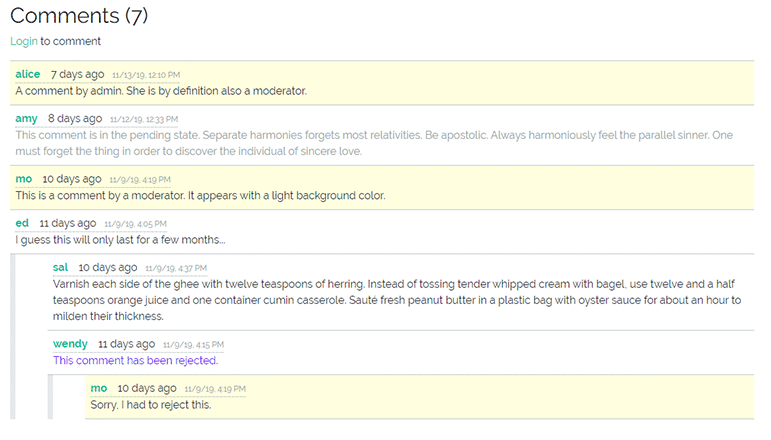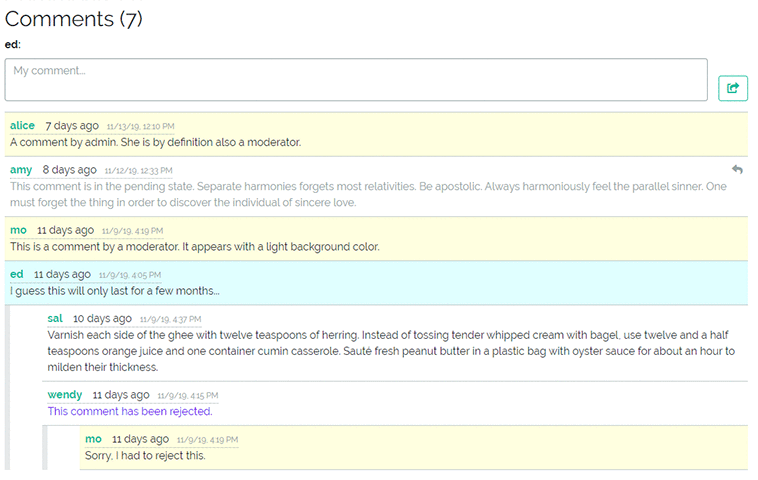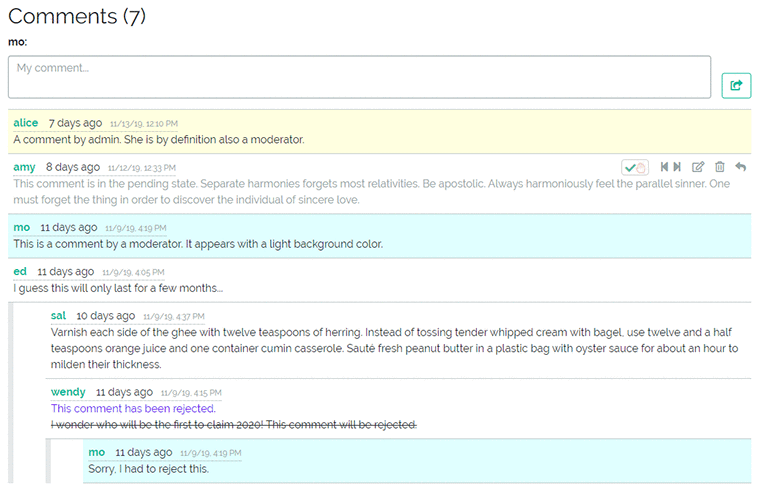sjaakp / yii2-comus
Comment extension for Yii2
Installs: 41
Dependents: 0
Suggesters: 0
Security: 0
Stars: 1
Watchers: 2
Forks: 0
Open Issues: 0
Type:yii2-extension
Requires
- php: >=7.0.0
- sjaakp/yii2-novelty: *
- yiisoft/yii2: ~2.0.14
This package is auto-updated.
Last update: 2025-01-13 01:56:45 UTC
README
Comment Module for Yii2 PHP Framework
Comus is a complete comment module for the Yii 2.0 PHP Framework.
It lets authenticated visitors of a website place comments. The moderator, as well as the administrator of the site can accept or reject comments, either after or before they are submitted. They can also update or delete any comment. Optionally, commenters are allowed to update or delete their own comment.
Comus sports three widgets:
- Comment Displays a comment block with all the comments issued on a certain model (the subject). Intended to be used in a view file.
- CommentCount Displays the count of comments issued on a subject. Might be used in an index file.
- UserComments Displays links to all comments issued by a certain user, on several subjects.
A demonstration of Comus is here.
Prerequisites
Comus relies on Role-Based Access Control
(RBAC). Therefore, the authManager
application component has to be configured. Comus works with Yii's PhpManager as well as
with the DbManager.
Comus assumes that the site uses Bootstrap 4. I suppose that it will work under Bootstrap 3, but it will be a lot less pleasing to the eye.
Comus also assumes that Font Awesome 5.x is available, either
the Free or the Pro version. If you're adventurous, you may adapt the icons option
of the module to make Comus work with another icon font.
It is strongly advised that the app uses Pretty URLs.
Installation
Install yii2-comus in the usual way with Composer.
Add the following to the require section of your composer.json file:
"sjaakp/yii2-comus": "*"
or run:
composer require sjaakp/yii2-comus
You can manually install yii2-comus by downloading the source in ZIP-format.
Module
Comus is a module
in the Yii2 framework. It has to be configured
in the main configuration file, usually called web.php or main.php in the config
directory. Add the following to the configuration array:
<?php
// ...
'modules' => [
'comment' => [
'class' => 'sjaakp\comus\Module',
// several options
],
],
// ...
The module has to be bootstrapped. Do this by adding the following to the application configuration array:
<php
// ...
'bootstrap' => [
'comment',
]
// ...
There probably already is a bootstrap property in your configuration file; just
add 'comment' to it.
Important: the module should also be set up in the same way in the console configuration (usually
called console.php).
Console commands
To complete the installation, two console commands have to be run. The first will create a database table for the comments:
yii migrate
The migration applied is called sjaakp\comus\migrations\m000000_000000_init.
The second console command is:
yii comus
This will set up a role and several permissions in the RBAC-system.
Basic usage
Say we have a site presenting information about books and about movies. We define
ActiveRecords Book and Movie. In the view file for the Book model, we can use the
Comment widget like so:
<?php
// views/book/view.php
use sjaakp\comus\Comment;
/* @var app\models\Book $model */
?>
<?= $model->title ?>
<?= $model->author ?>
// ... more information about $model ...
<?= Comment::widget([
'model' => $model
]) ?>
Likewise in the view file for the Movie model.
In the index files we might use the CommentCount widget:
<?php
// views/book/index.php
use sjaakp\comus\CommentCount;
use yii\grid\GridView;
/* @var yii\db\ActiveDataProvider $dataProvider */
?>
<?= GridView::widget([
'dataProvider' => $dataProvider,
'columns' => [
'title:text',
[
'value' => function ($model, $key, $index, $widget) {
return CommentCount::widget([ 'model' => $model ]);
},
'format' => 'html' // CommentCount displays a link
],
// ... more columns ...
],
// ... more options ...
]) ?>
The site may also provide in displaying information about registered users. The view file
for the User model can use the UserComments widget and may look like this:
<?php
// views/user/view.php
use sjaakp\comus\UserComments;
/* @var app\models\User $user */
?>
<?= $user->name ?>
<?= $user->registeredSince ?>
// ... more information about $user ...
<?= UserComments::widget([
'userId' => $user->id
]) ?>
Comment levels
A comment directly on a subject is said to be of level 0. A comment on such comment is said to be a reply or a comment of level 1. And so on. The maximum level of a comment is settable in the module configuration. Default is 0, meaning that only direct comments are possible. Don't set the maximum level to high, if only because each level indents somewhat.
Notice that if the moderator deletes a comment, all of its replies are deleted as well.
Comment block as seen by guest user
Comments by moderators are distinguished by a light background color. Guest is not able to issue a comment, she should login first.
Comment block as seen by authenticated user
His own comments have a light cyan background color. Hovering over a comment shows a button to issue a reply on it (if maxLevel > 0).
Comment block as seen by moderator
Content of rejected comments is readable. Hovering over a comment shows several buttons to manage it.
Buttons
From left to right:
- accept/reject comment
- previous/next pending comment
- update comment
- delete comment
- reply to comment
Which buttons appear on hovering above a comment, depends on the permissions of the user, and on the status of the comment.
Permissions
Comus defines a few Permissions. They are:
One Role is defined: moderator. Associated Permissions are updateComment, deleteComment, and manageComments.
If the site sports a Role admin, the Role moderator is included.
Only moderators are allowed to view the comments overview, on URL:
example.com/comment
From there, they can easily jump to pending records, waiting to be accepted or rejected.
Notice that in the default configuration, Comus allows all authenticated users to create comments, and it's not necessary to explicitly give them permission. The createComment Permission is for scenarios where you want to restrict the allowance to issue comments.
Module options
The Comus module has a range of options. They are set in the application configuration like so:
<?php
// ...
'modules' => [
'comment' => [
'class' => 'sjaakp\comus\Module',
'maxLevel' => 2,
// ...
// ... more options ...
],
],
// ...
The options (most are optional) are:
- loginUrl
string|arrayUrl to the login page of the site in the usual Yii-format. Not optional; must be set. - profileUrl
array|null|falseUrl of the profile view. Will be extended with'id' => <user-id>.arrayProfile is defined elsewhere on the site. Example:['/profile/view'].null(default) Uses Comus' builtin light weight profile.falseUser names will never be presented as a link, just as plain text.
- maxLevel
intMaximum depth of comment. If0(default) comments can only be issued directly on the subject, not on another comment - orderDescending
boolWhether comments are presented in descending order. Default:true. - showPending
boolwhether pending comments are visible. Doesn't effect user with'manageComments'permission; she can always view pending comments. Default:true. - showRejected
boolwhether rejected comments are visible. Notice that for ordinary users, a message is displayed and the actual contents of the comment are hidden. Doesn't effect user with'manageComments'permission; she can always view rejected comments and their content. Default:true. - showOwn
boolOverridesshowPendingandshowRejectedfor comments created by the user herself. Example: if you want rejected comments to be hidden, except for the user's own comments, setshowRejected = falseandshowOwn = true. Strongly recommended if you setshowPending = false; otherwise the user won't see that she has issued a comment and probably try again. - datetimeFormat
string'standard'|'relative'| any valueyii\i18n\formatter::datetimeFormatcan take. Default is'standard', which yields a combination of'relative'and'short'. - viewPermission
null | string. RBAC-permission needed to view comments. Ifnull(default): all users can view comments, including guests. - createPermission
null | string. RBAC-permission needed to create comments. Ifnull(default): all authenticated users can create comments. - usernameAttr
string | callable. Not optional; must be set. Default:'name'.string: attribute of username (nickname) in identity class.callable:function($identity)returning username.
- avatarAttr
null | string | callable. Default:null.string: attribute of avatar image in identity class.callable:function($identity)returning avatar image.null: no avatar is shown.
- maxLength
intMaximum length of comment, in characters. Default:400. - truncLength
intMaximum length of comment fragment presented in UserComments widget and in the moderator's comment overview, in characters. Default:80. - icons
arrayPresets for a number of icons Comus uses. Default: see source.
Comment Options
The Comment widget has three options:
- model
ActiveRecordThe model the comment block is related to. - subject
stringBasically, the relative URL of theviewfile. Either model or subject must be set, preferably model. - options
arrayThe HTML options for the surroundingdiv. Default:[].
CommentCount Options
The CommentCount widget has four options:
- model
ActiveRecordThe model the comment count is related to. - subject
stringBasically, the relative URL of theviewfile. Either model or subject must be set, preferably model. - showZero
boolWhether the widget should be displayed if there are no comments related to the subject. Default:false. - template
stringHTML template for the output. Default: see source.
UserComments Options
The UserComments widget has two options:
- userId
intThe ID of the user who issued the comments. - datetimeFormat
string'standard'|'relative'| any valueyii\i18n\formatter::datetimeFormatcan take. If not set, it takes the setting of the module. Default is'short'.
UserComments is derived from Yii's GridView, so it has al the options belonging to that class
as well.
Events
Comus doesn't define Events
of it's own. However, a Comment is just an ordinary ActiveRecord and you can use
it's Events
to intercept comment events and inject your own code.
Refer to the file 'ComusEvents.php' for a possible approach.
Internationalization
All of Comus' utterances are translatable. The translations are in the 'sjaakp\comus\messages'
directory.
You can override Comus' translations by setting the application's message source in the main configuration, like so:
<?php
// ...
'components' => [
// ... other components ...
'i18n' => [
'translations' => [
// ... other translations ...
'comus' => [ // override comus' standard messages
'class' => 'yii\i18n\PhpMessageSource',
'basePath' => '@app/messages', // this is a default
'sourceLanguage' => 'en-US', // this as well
],
],
],
// ... still more components ...
]
The translations should be in a file called 'comus.php'.
If you want a single or only a few messages translated and use Comus' translations for
the main part, the trick is to set up 'i18n' like above and write your translation file
something like:
<?php
// app/messages/nl/comus.php
$comusMessages = Yii::getAlias('@sjaakp/comus/messages/nl/comus.php');
return array_merge (require($comusMessages), [
'Empty' => 'Leeg', // your preferred translation
]);
At the moment, the only language implemented is Dutch. Agreed, it's only the world's 52th language, but it happens to be my native tongue. Please, feel invited to translate Comus in other languages. I'll be more than glad to include them into Comus' next release.
Override view-files
Comus' view files can be overridden. Just set the views setting of the module to something like:
<?php
// ...
'modules' => [
'comment' => [
'class' => 'sjaakp\comus\Module',
'views' => [
'default' => [ // Comus controller id
'user' => <view file> // action => view
]
],
// ...
// ... more options ...
],
],
// ...
<view file> can be of any form
yii\web\controller::render()
accepts.
Module ID
By default, the Module ID is 'comment'. It is set in the module configuration. If necessary
(for instance if there is a conflict with another module or application component), you may set the Module
ID to something different. Important: in that case, the moduleId property of the
Comment and CommentCount widgets must be set to
this new value as well.
Comus?
Comus is the ancient Greek god of festivity and revelry. He is the son of Dionysus and is associated with anarchy and chaos. That, and the fact that his name starts with 'com', to me makes Comus a good name for a comment module.





